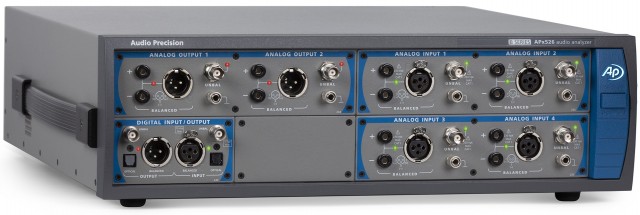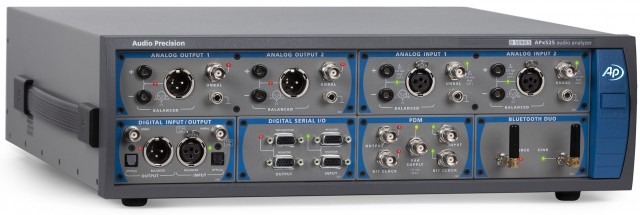
APx52x B Series Audio Analyzers
APx52x B Series Modular, Two- and Four-Channel Performance Audio Analyzers
The ideal balance of analog performance and breadth of digital I/O.
The B Series APx525 is a two-channel audio analyzer for R&D engineers and production technicians who want fast and easy audio testing, but who may not need the ultra-high performance of AP’s APx555 nor require the multichannel capability of the APx585.
Versatility in I/O
APx525 has two balanced and two unbalanced analog inputs and outputs plus 216k digital inputs and outputs via AES/EBU, TOSLINK and SPDIF. APx526 is the four-channel version of the APx525, developed for the four channel head units typical of the automotive audio industry.
Additionally, I/O may be expanded with optional Digital Serial (APx525 and APx526), HDMI + ARC (APx525), PDM (APx525 and APx526) and Bluetooth (APx525 and APx526) modules. Additionally, the optional Advanced Master Clock (AMC) module handles input and output clock signals to synchronize the APx52x Series with external equipment (or vice versa), and the AMC also enables jitter generation and analysis (in conjunction with Advanced Digital, Digital Serial or PDM modules).
NOTE: B Series APx analyzers are only compatible with APx500 software version 5 and later. If your audio test requirements include the ability to run an earlier version of APx500 software, please contact your sales partner for further information.
Features
Transfer Function
APx500 software release 5.0 adds the ability to measure the transfer function of electronic audio and electroacoustic devices. The transfer function measurement provides the complex frequency response function for a device, including the magnitude and phase (or real and imaginary components), using any broadband signal. This feature, a powerful addition to APx software’s Sequence Mode, allows any APx analyzer to be used as a multichannel dynamic signal analyzer or as a so called dual-channel FFT analyzer. With transfer function and any broadband signal, including speech, music, or noise, APx users can now assess the complex frequency response, coherence, and impulse response of their device or system. AP’s transfer function provides gapless and overlapped analysis of multiple acquisitions. It also includes a ground-breaking signal-based triggering that eliminates the need for a pilot tone in open-loop test applications, making it ideal for test of “smart” audio devices.
Open-Loop Chirp
With release v4.6, APx500 software now enables open-loop measurements using the logarithmically-swept sine, or chirp, test signal. This signal provides multiple, high-resolution results in a brief period of time and now APx users can employ the chirp in test scenarios where the signal may originate, or terminate, as a file on the device under test (DUT) or on a server connected to the DUT. This new capability is especially helpful to those developing smart devices (e.g., smart speakers, smartphones).
Jitter Analysis
Jitter in digital audio systems may cause audible distortion in the form of jitter sidebands in the output signal. Jitter tolerance testing can reveal jitter induced distortion but is often neglected in the design of circuits and components because it is difficult and time consuming. Audio Precision APx analyzers provide jitter generation and jitter analysis features to simplify jitter testing.
Code-Free Automation and a Complete API
APx500 Measurement Software is the most advanced audio measurement interface available. Complex procedures that include user prompts, limits, and calls to external applications can be created directly in the GUI, saving time and money while ensuring painless updates over time, as no development is required.
Create custom interfaces and application-to-application automation using the comprehensive APx API. Extensive documentation and examples are provided for Visual Basic.NET, C#, MATLAB, LabVIEW, and Python. Projects and automation can be shared with other APx units anywhere in the world.
Common Software Platform
From a practical perspective, APx audio analyzers use a common software platform, making tests and results easier to share. All settings for a test are saved in a single project file, making it easy to replicate test setups between R&D and production facilities anywhere in the world. Project files are compatible with both B Series and Legacy APx instruments and each project is self-contained, so there’s never any worry about dependencies or broken links. Users can even embed waveform files and images within a project file.
For sharing measurement results with customers, contract manufacturers or management, APx automatically generates rich graphic reports, with highlighted pass / fail limits and options to export as PDF, HTML, Excel, CSV, RTF or MATLAB files.
Digital Protocol Analysis
Modern consumer devices such as televisions, Blu-ray players, and receivers typically use a digital interface such as S/PDIF, Toslink, HDMI to transmit audio signals. In addition to the digital audio data, these interfaces also carry auxiliary information about the audio signal, metadata. The APx Metadata monitors decode and display metadata values as they are received from the device under test.
Options
High-Performance Options – AG52 and BW52
Developed for power amp designers, the AG52 analog generator option generates exceptionally clean square waves with a rise time better than 2 microseconds and has an improved THD+N of -110 dB (typical). The AG52 generates DIM 100, 30, and B square + sine waveforms and maximum output level is increased from 21.21Vrms to 26.66 Vrms (balanced).
The BW52 ultra-high bandwidth option offers advanced FFT performance: 1.248 million points, DC to 1 MHz bandwidth and full 24-bit resolution. Ideal for Class D amplifier design.
Advanced Digital I/O (option)
Provides AES3, AES/EBU balanced digital I/O on XLR; unbalanced SPDIF digital I/O on BNC; and TOSLINK optical digital I/O. The APx ADIO module enables the generation of advanced impairments for sophisticated test of devices via AES/SPDIF/TOSLINK. It also includes the Advanced Master Clock (AMC) module, which handles input and output clock signals for synchronizing an APx with external equipment (or vice versa). AMC also provides jitter generation and measurement functionality for jitter-enabled I/O modules such as ADIO, DSIO and PDM.
Advanced Master Clock (option)
The AMC module handles input and output clock signals to synchronize the APx52x B Series with external equipment (or vice versa). This module also enables jitter generation and analysis in APx500 Series analyzers with Advanced Digital (ADIO), Digital Serial (DSIO) or PDM modules installed.
ASIO (standard)
PC audio interfaces with installed ASIO drivers appear within the APx500 software as one of APx’s I/O options, with support for up to 16 bidirectional channels. All measurements and test sequences in APx may be used via the ASIO interface, allowing for complete characterization of the connected audio device.
Bluetooth Duo (option)
Audio Precision’s next-generation Bluetooth® module, the APx Bluetooth Duo™, delivers a wider selection of A2DP codecs, faster pair and connection times, an increased feature set within APx500 measurement software, and improved RF shielding for use in production test environments. APx Duo supports Bluetooth core specification v4.2, HFP v1.7, HSP v1.2, AVRCP v1.4 and A2DP v1.3. Note: APx Bluetooth Duo requires v4.5 APx500 software (or later) and can only be installed on “Type E” APx chassis (manufactured after August 2012).
Bluetooth Legacy (option)
APx’s Bluetooth module, with built-in radio and software stack, allows engineers to measure their Bluetooth devices directly. All Bluetooth controls are integrated into the analyzer software and APx supports A2DP, HFP 1.6, and AVRCP profiles. Codec support includes SBC, aptX, CVSD, and wideband speech (mSBC).
PDM 16 (option)
PDM 16 is an optional input module providing sample-accurate inter-channel phase information for up to 16 channels of pulse density modulated signals. With its acoustically-silent remote pod and extension cable preserving PDM signal integrity for up to 10 meters, PDM 16 readily supports MEMS microphone measurements in anechoic chambers. As an added feature, the module can provide up to 50 mA Vdd power supply to the device, or devices, under test.
PDM (option)
The APx PDM option provides direct connectivity for audio devices that have a PDM (pulse density modulation) output such as a MEMS microphone, or an input such as the decimator on a smartphone chip. In addition to standard audio measurements, APx provides variable DC voltage, variable sample rate, and PSR (power supply rejection) measurements for testing devices’ full operating parameters. Jitter capable.
Digital Serial I/O (option)
Digital serial capability is essential in R&D for evaluating designs at the circuit board level. The Digital Serial I/O (DSIO) option provides a direct multichannel connection to chip-level interfaces such as I2S, TDM, and other popular serial interface formats including left-justified, right-justified, and DSP. Jitter capable.
HDMI + ARC (option)
The APx HDMI option allows engineers to measure HDMI audio quality and audio format compatibility on devices such as surround sound receivers, set-top boxes, smartphones, tablets, TVs, and DVD or Blu-ray Disc™ players. APx can stream both lossless and compressed formats from pre-encoded audio test files, making it easy to troubleshoot component compatibility and issues related to downsampling, downmixing, or transcoding.
Specification
| GENERATOR PERFORMANCE | ANALYZER PERFORMANCE |
| Sine Frequency Range: 0.1 Hz to 80.1 kHz Frequency Accuracy: 2 ppm IMD Test Signals: SMPTE, MOD, DFD Maximum Amplitude (balanced): 21.21 Vrms Amplitude Accuracy: ±0.03 dB Flatness (20 Hz–20 kHz): ±0.008 dB Residual THD+N (20 kHz BW): –105 dB + 1.4 µV Typically <–108 dB (1 kHz, 2.5 V) Typically <–110 dB (1 kHz, 2.5 V – option AG52 installed) Analog Output Configurations: Unbalanced & balanced Digital Output Sampling Rate: 27 kS/s to 200 kS/s or 27 kS/s to 108 kS/s Optical Dolby / dts Generator: Yes (encoded file) | Maximum Rated Input Voltage: 230 Vpk Maximum Bandwidth: >90 kHz or >1 MHz [with BW52] IMD Measurement Capability: SMPTE, MOD, DFD Amplitude Accuracy (1 kHz): ±0.03 dB Amplitude Flatness (20 Hz–20 kHz): ±0.008 dB Residual Input Noise (20 kHz BW): 1.3 µV Residual THD+N (20 kHz BW): –105 dB + 1.4 µV Typically <–108 dB (1 kHz, 2.5 V) Typically <–110 dB (1 kHz, 2.5 V – option AG52 installed) Individual Harmonic Analyzer: d2–d10 Max FFT Length: 1248K points DC Voltage Measurement: Yes |
Specifications
SYSTEM REQUIREMENTS
• Microsoft Windows 10 (64-bit) operating system.
• USB 2.0 or USB 3.0. Two are required for optional switcher or DCX-127 use.
• Intel i5 or better processor running at a clock speed of at least 2.5 GHz. AMD processors with similar specifications are also supported.
• At least 8 GB RAM. 16 GB is highly recommended
internet connection or CD-ROM drive (to access APx500 software for installation).
• At least 1.5 GB of free hard disk space. An SSD for the operating system drive is recommended.
• A color monitor and video card with at least SXGA (1280 X 1024) video graphics support. Video resolution of 1900 x 1080 or greater is recommended.
• More detailed information is available on our AP Software and Windows Compatibility chart
Document
NOTES
- System performance is sensitive to processor speed; faster processors will yield faster results.
- APx500 is data intensive and it is recommended that other data-intensive applications not be run concurrently. This includes Audio Precision AP2700, APWIN or ATS.















